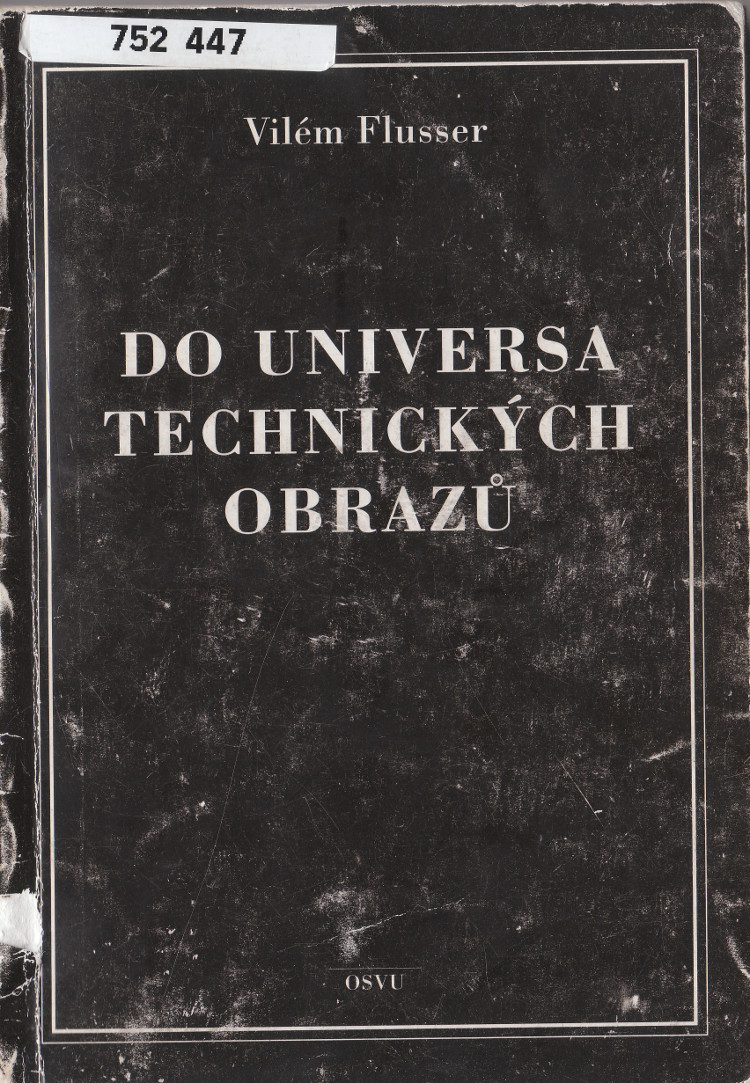Vilém Flusser: Into the Universe of Technical Images (1985–) [DE, HU, CZ, EN]
Filed under book | Tags: · communication technology, computing, cybernetics, database, entropy, image, media, media theory, philosophy, photography, postmodernism, technical image, technology, theory, virtual reality


Poised between hope and despair for a humanity facing an urgent communication crisis, this work by Vilém Flusser forecasts either the first truly human, infinitely creative society in history or a society of unbearable, oppressive sameness, locked in a pattern it cannot change. First published in German in 1985 and now available in English for the first time, Into the Universe of Technical Images outlines the history of communication technology as a process of increasing abstraction.
Flusser charts how communication evolved from direct interaction with the world to mediation through various technologies. The invention of writing marked one significant shift; the invention of photography marked another, heralding the current age of the technical image. The automation of the processing of technical images carries both promise and threat: the promise of freeing humans to play and invent and the threat for networks of automation to proceed independently of humans.
Originally published in German as Ins Universum der technischen Bilder, European Photography, 1985
Czech edition: Do universa technických obrazů
Translated by Jiří Fiala
Publisher OSVU, 2002
ISBN 8023875698
162 pages
English edition
Translated by Nancy Ann Roth
Introduction by Mark Poster
Publisher University of Minnesota Press, 2011
Volume 32 of Electronic Mediations
ISBN 0816670218, 9780816670215
224 pages
Review (Bob Hanke, International Journal of Communication)
Translator (EN)
Publisher (EN)
Ins Universum der technischen Bilder (German, 1985, added on 2016-8-4)
A technikai képek univerzuma felé (Hungarian, trans. József Maleczki, 2001; revised trans. Dalma Török, 2011; HTML, added on 2014-2-14)
Do universa technických obrazů (Czech, Jiří Fiala, 2002, no OCR, added on 2013-4-1)
Into the Universe of Technical Images (English, trans. Nancy Ann Roth, 2011, updated on 2012-7-17)
Jay David Bolter, Richard Grusin: Remediation: Understanding New Media (1999)
Filed under book | Tags: · computer games, digital art, film, media, new media, painting, photography, radio, remediation, self, technology, television, ubiquitous computing, virtual reality, web

Media critics remain captivated by the modernist myth of the new: they assume that digital technologies such as the World Wide Web, virtual reality, and computer graphics must divorce themselves from earlier media for a new set of aesthetic and cultural principles. In this richly illustrated study, Jay David Bolter and Richard Grusin offer a theory of mediation for our digital age that challenges this assumption. They argue that new visual media achieve their cultural significance precisely by paying homage to, rivaling, and refashioning such earlier media as perspective painting, photography, film, and television. They call this process of refashioning “remediation,” and they note that earlier media have also refashioned one another: photography remediated painting, film remediated stage production and photography, and television remediated film, vaudeville, and radio.
Publisher: MIT Press, 1999
ISBN: 0262024527, 9780262024525
295 pages
PDF (CHM; updated on 2012-9-3)
PDF (low quality PDF; added on 2012-9-3)
Jacques Derrida, Bernard Stiegler: Echographies of Television: Filmed Interviews (1996/2002)
Filed under book | Tags: · literature, mass media, media studies, philosophy, photography, recording, sociology, technology, teletechnologies, television

“In this book, Jacques Derrida talks with Bernard Stiegler about the effect of teletechnologies on our philosophical and political moment. Improvising before a camera, the two philosophers are confronted by the very technologies they discuss and so are forced to address all the more directly the urgent questions that they raise. What does it mean to speak of the present in a situation of “live” recording? How can we respond, responsibly, to a question when we know that the so-called “natural” conditions of expression, discussion, reflection, and deliberation have been breached?
As Derrida and Stiegler discuss the role of teletechnologies in modern society, the political implications of Derrida’s thought become apparent. Drawing on recent events in Europe, Derrida and Stiegler explore the impact of television and the internet on our understanding of the state, its borders and citizenship. Their discussion examines the relationship between the juridical and the technical, and it shows how new technologies for manipulating and transmitting images have influenced our notions of democracy, history and the body. The book opens with a shorter interview with Derrida on the news media, and closes with a provocative essay by Stiegler on the epistemology of digital photography.”
First published as Echographies de la télévision – Entretiens filmés, Galilée, Paris, 1996.
Translated by Jennifer Bajorek
Publisher Polity Press, 2002
ISBN 0745620361, 9780745620367
174 pages
PDF (no OCR; updated on 2012-7-19)
Comment (0)
